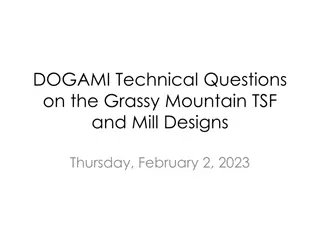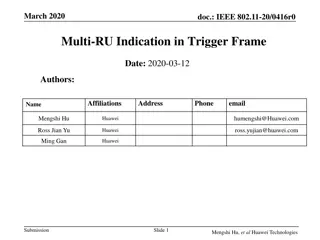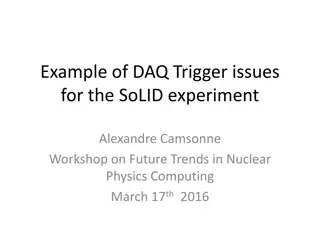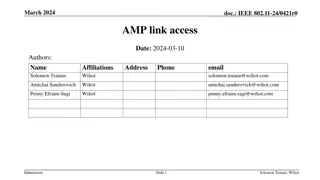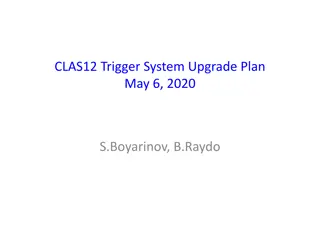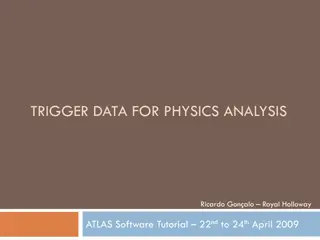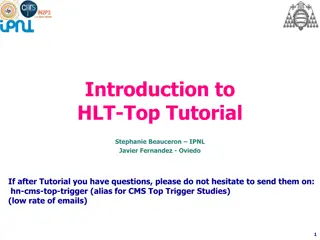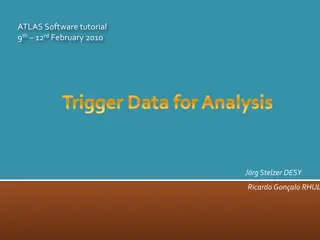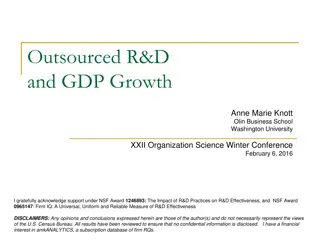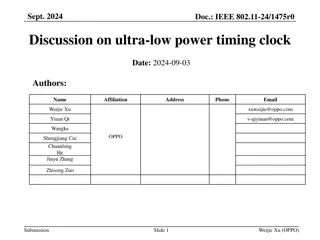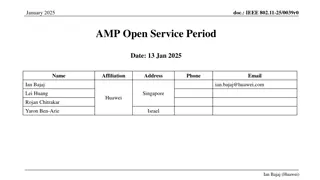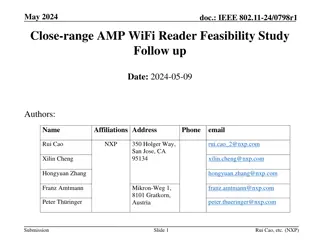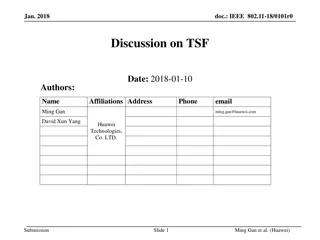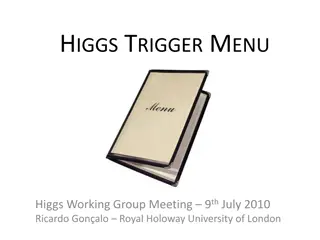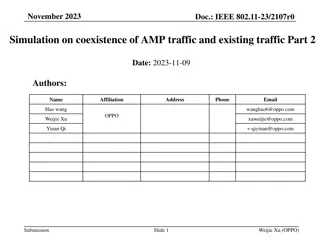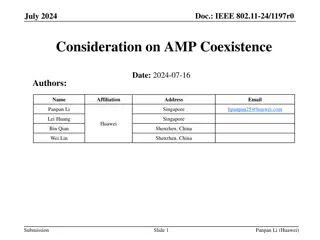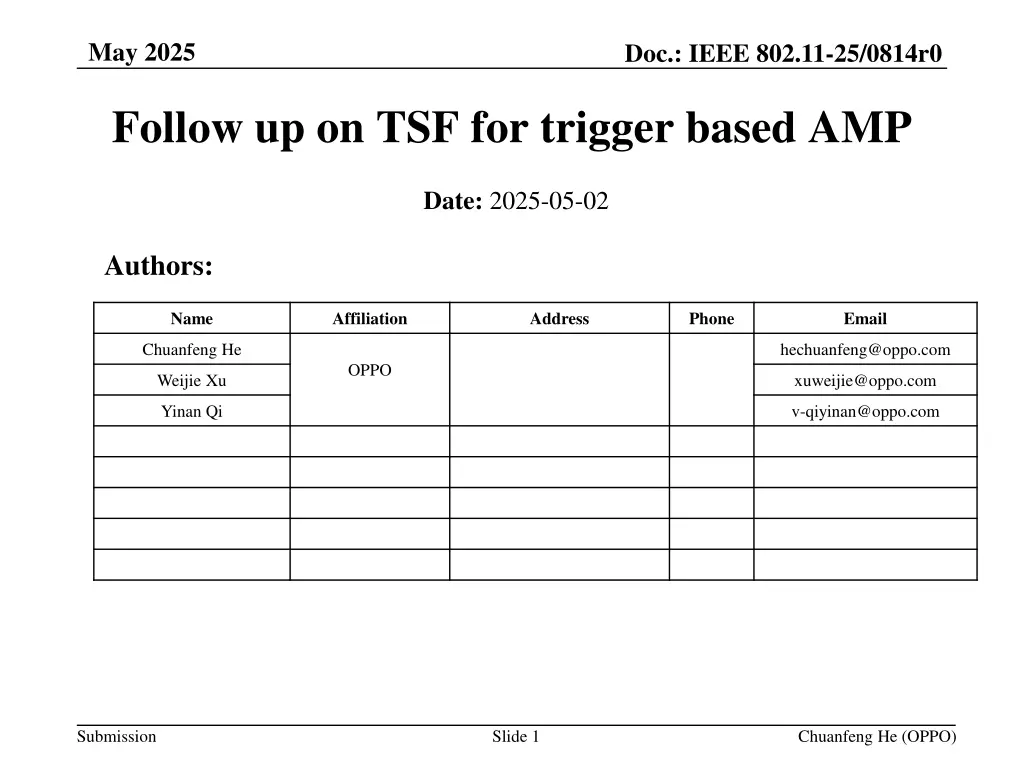
IEEE 802.11-25/0814r0 Follow-up on Trigger-Based AMP
Explore the latest developments in IEEE 802.11-25/0814r0 regarding trigger-based AMP, TSF support, duty cycle operation, and uplink PPDU transmission. Understand the timestamp requirements, operation durations for AMP stations, and more for efficient network communication.
Download Presentation

Please find below an Image/Link to download the presentation.
The content on the website is provided AS IS for your information and personal use only. It may not be sold, licensed, or shared on other websites without obtaining consent from the author. If you encounter any issues during the download, it is possible that the publisher has removed the file from their server.
You are allowed to download the files provided on this website for personal or commercial use, subject to the condition that they are used lawfully. All files are the property of their respective owners.
The content on the website is provided AS IS for your information and personal use only. It may not be sold, licensed, or shared on other websites without obtaining consent from the author.
E N D
Presentation Transcript
May 2025 Doc.: IEEE 802.11-25/0814r0 Follow up on TSF for trigger based AMP Date: 2025-05-02 Authors: Name Affiliation Address Phone Email Chuanfeng He hechuanfeng@oppo.com OPPO Weijie Xu xuweijie@oppo.com Yinan Qi v-qiyinan@oppo.com Submission Slide 1 Chuanfeng He (OPPO)
Doc.: IEEE 802.11-25/0814r0 May 2025 Background The motion about the support of AMP TSF, duty cycle operation and the trigger based AMP uplink PPDU transmission were agreed.[1] MM-1: If AMP device is able to support AMP TSF, the maximum timing offset is 104 ppm. MM-2: 11bp defines a mechanism to allow an AP to solicit AMP uplink PPDU(s) from one or more 802.11bp clients. MM-4: If an AMP device is able to support TSF, it can monitor AMP DL Frame in a duty-cycle manner. PM-2: 11bp defines at least one mode of MAC/PHY that allows an AMP-only device with active uplink communication in 2.4GHz subject to the following requirements: clock accuracy requirement is relaxed compared to legacy 802.11 devices; the active uplink communication can only be sent in response to being polled by the AP. Submission Slide 2 Chuanfeng He (OPPO)
May 2025 Doc.: IEEE 802.11-25/0814r0 Recap: Timestamp Timestamp in legacy 802.11 standards Timestamp is used to synchronize the TSF timer of non-AP STAs in BSS. TSF timer is used for STAs to derive the time of TBTT, TWT, SP, and so on. Each STA shall maintain a TSF timer which is able to span 264 microseconds. The size of timestamp is 8 Octets, which is carried in Beacon or Probe Response frame. Submission Slide 3 Chuanfeng He (OPPO)
May 2025 Doc.: IEEE 802.11-25/0814r0 Operation duration of AMP STA Operation duration for logistics like use cases[2] Assumption Starting from maximum available energy storage for operating: 4.125 J Power consumption during initial trigger searching window(0.35 J) 20ms@15 W(i.e. 0.3 J) for sync detection. 0.5ms@100 W (i.e. 0.05 J) for initial trigger frame Rx and decoding. Power consumption during Duty-cycle operation(1.65 J) In each duty cycle, energy for sync searching: [2ms + 5ms =7ms] * 15 W=0.105 J; Energy consumption for total 10 NSPs for sync searching: 10*[2ms + 5ms =7ms] * 15 W=1.05 J; Energy consumption for total 10*100 W*0.5ms=0.5 J Energy consumption for solicited data Tx: 200 W*0.5ms=0.1 J. Total energy consumption: 1.05+0.5+0.1=1.65 J. 10 NSPs for trigger frame Rx: Submission Slide 4 Chuanfeng He (OPPO)
May 2025 Doc.: IEEE 802.11-25/0814r0 Operation duration of AMP STA Operation duration after wake up[2] Duty cycle period: 200ms Initial trigger searching window(ITSW) duration: 20ms Duty-cycle operation duration Duty-cycle operation duration includes several duty cycle periods. For use case such as logistics, AP may try to traverse all the AMP STAs with same Duty-cycle configuration within a Duty-cycle operation duration, based on random access mechanism. A Duty-cycle operation duration should not be too long because of latency and limited energy storage. It is assumed a Duty-cycle operation duration includes 10 duty cycle periods. Operation duration: ITSW duration + 10*duty cycle period is about 2.02s. Submission Slide 5 Chuanfeng He (OPPO)
May 2025 Doc.: IEEE 802.11-25/0814r0 Timestamp size for AMP TSF Factors to determine timestamp size for AMP TSF The timing granularity of AMP TSF Significantly relax the timing granularity requirement for AMP, e.g. to 1024us, is acceptable Since the TSF clock accuracy is 10^4 ppm, for a 200ms duty cycle, 2ms early wake-up is needed. Hence, it is not necessary to maintain fine timing granularity(i.e. 1us). The range of AMP TSF The range of AMP TSF can be determined depending on the length of whole operation duration (e.g., time spending for the whole inventory procedure) or the length of duty cycle period. For the operation duration, TSF timer only needs to cover operation duration to finish the solicited UL data Tx. For duty cycle period, TSF timer is used to determine the trigger Tx window within the duty cycle period based on the Duty-cycle configuration. Submission Slide 6 Chuanfeng He (OPPO)
May 2025 Doc.: IEEE 802.11-25/0814r0 Timestamp size for AMP TSF Example timestamp size for AMP TSF With the timing granularity of 1024us E.g., Timestamp size is ~11bits to cover a operation duration of 2s. E.g., Timestamp size is ~ 8bits to cover a 200ms duty cycle period. Submission Slide 7 Chuanfeng He (OPPO)
May 2025 Doc.: IEEE 802.11-25/0814r0 Timestamp for AMP TSF Observations: The total operation duration after wake up may be short due to limited energy storage and low latency for logistics like use cases. The TSF timer can only need to cover operation duration to make AMP STA timing synchronized before success UL PPDU transmission. Based on the assumption on energy storage and the procedure of success UL PPDU transmission, one practical maximum operation duration is 2.02s, which leads to 11 bits timestamp to cover it, with timing granularity of 1024us. Consider the low latency for logistics like use cases, maximum duty cycle period, e.g. 200ms, can be assumed, which leads to only 8 bits timestamp to cover it, with timing granularity of 1024us. Proposals: Introduce short timestamp for AMP TSF. Submission Slide 8 Chuanfeng He (OPPO)
May 2025 Doc.: IEEE 802.11-25/0814r0 Timestamp delivery Why deliver timestamp in AMP trigger: The main contribution of timestamp is to allow Duty-cycle operation for trigger monitoring. The main behavior of AMP STAs is the monitoring of AMP trigger after wakeup. The trigger interval should be short in logistics like use cases, due to energy constraints and low latency requirement. It means AMP trigger is transmitted more frequently, which leads to easier detection for AMP STA after wakeup with less energy consumption. Why do not deliver timestamp in Beacon: Beacon is a parallel frame for AMP STA. It may have functionalities other than AMP trigger. Typical beacon interval is 100ms, which is too long for AMP STA to search after wakeup. It requires more energy consumption for initial beacon searching than that for trigger. If we consider short beacon interval, e.g. equal to trigger interval, the overhead and energy consumption will be equivalent for beacon and trigger. After detecting beacon, AMP STA still has to further receive trigger for UL PPDU transmission. Separate reception of timestamp and trigger brings additional complexity and energy consumption. Proposal: AMP STA can obtain a short timestamp through AMP trigger. Submission Slide 9 Chuanfeng He (OPPO)
May 2025 Doc.: IEEE 802.11-25/0814r0 Timestamp delivery in AMP Trigger TSF timer start or alignment based on timestamp in AMP trigger. Service period starting determination based on TSF timer. TSF timer spanning at least one duty cycle period. Submission Slide 10 Chuanfeng He (OPPO)
May 2025 Doc.: IEEE 802.11-25/0814r0 Proposal Introduce short timestamp for AMP TSF. The length of timestamp is TBD. AMP STA can obtain a short timestamp through AMP DL Frame sent by AP for soliciting AMP uplink PPDU(s) from one or more 802.11bp clients. Submission Slide 11 Chuanfeng He (OPPO)
May 2025 Doc.: IEEE 802.11-25/0814r0 Straw Poll #1 Do you agree with the following text: Short timestamp is defined to support AMP TSF. The length of timestamp is TBD. Yes No Abstain Submission Slide 12 Chuanfeng He (OPPO)
May 2025 Doc.: IEEE 802.11-25/0814r0 Straw Poll #2 Do you agree with the following text: If an AMP device is able to support TSF, it can obtain timestamp through AMP DL Frame sent by AP for soliciting AMP uplink PPDU(s) from one or more 802.11bp clients. Yes No Abstain Submission Slide 13 Chuanfeng He (OPPO)
May 2025 Doc.: IEEE 802.11-25/0814r0 Reference 1. 2. 3. 4. IEEE 802.11-24/1613r4, Specification framework for tgbp IEEE 802.11-25/0813r0,Follow up on Duty-cycle operation for AMP, OPPO IEEE 802.11-25/0341r0, Details of Duty cycle operation for AMP, OPPO IEEE 802.11-25-0342r0, TSF for trigger based AMP communication Submission Slide 14 Chuanfeng He (OPPO)


